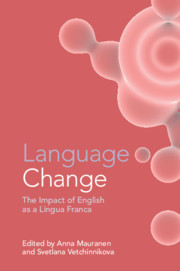Book contents
- Language Change
- Language Change
- Copyright page
- Contents
- Figures
- Tables
- Contributors
- Acknowledgements
- Abbreviations
- Introduction
- Part I Pooling Perspectives
- Part II Zooming in on ELF
- 7 ELF, Language Change, and Social Networks
- 8 ELF and Language Change at the Individual Level
- 9 Are Multilinguals the Better Academic ELF Users?
- 10 The Role of Co-Textual and Contextual Cues for Intelligibility in ELF Interactions
- 11 Exploring the Pragmatics of Computer-Mediated English as a Lingua Franca Communication
- 12 Development of Shared Multilingual Resources in ELF Dyadic Interaction
- 13 The Role of Translanguaging in ELF Advice Sessions for Asylum Seekers
- Index
- References
11 - Exploring the Pragmatics of Computer-Mediated English as a Lingua Franca Communication
Multimodal and Multilingual Practices
from Part II - Zooming in on ELF
Published online by Cambridge University Press: 17 December 2020
- Language Change
- Language Change
- Copyright page
- Contents
- Figures
- Tables
- Contributors
- Acknowledgements
- Abbreviations
- Introduction
- Part I Pooling Perspectives
- Part II Zooming in on ELF
- 7 ELF, Language Change, and Social Networks
- 8 ELF and Language Change at the Individual Level
- 9 Are Multilinguals the Better Academic ELF Users?
- 10 The Role of Co-Textual and Contextual Cues for Intelligibility in ELF Interactions
- 11 Exploring the Pragmatics of Computer-Mediated English as a Lingua Franca Communication
- 12 Development of Shared Multilingual Resources in ELF Dyadic Interaction
- 13 The Role of Translanguaging in ELF Advice Sessions for Asylum Seekers
- Index
- References
Summary
On the basis of an interdisciplinary approach informed by ethnographic methods, and computer-mediated discourse analysis, this paper sets out to explore the relationship between multimodal and multilingual practices in Computer-Mediated English as a Lingua Franca (CMELF) communication on Facebook. As the analysis of some naturally occurring interactions shows, CMELF users exploit multimodal resources in novel ways to achieve mutual understanding in intercultural communication. For instance, when a target term in English is unknown to the subject utterer, a corresponding picture can be searched for on the Internet in their own L1, to be then embedded in the CMELF utterance and fill the lexical gap. Multimodal resources, however, can also be employed as part of pragmatic strategies to proactively avoid misunderstanding: emojis, for example, can be used to flag words which are infrequent and therefore potentially problematic for the intended multicultural audience, while pictures can gloss these visually, thus enhancing utterance clarity.
Keywords
- Type
- Chapter
- Information
- Language ChangeThe Impact of English as a Lingua Franca, pp. 291 - 310Publisher: Cambridge University PressPrint publication year: 2020
References
- 2
- Cited by

